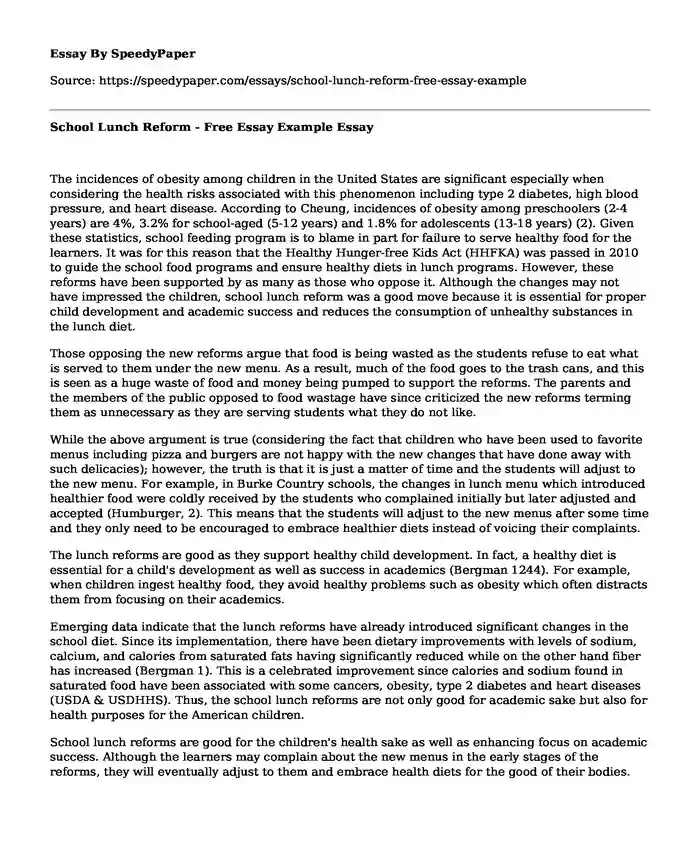
| Type of paper: | Argumentative essay |
| Categories: | School Child development Nutrition |
| Pages: | 3 |
| Wordcount: | 667 words |
The incidences of obesity among children in the United States are significant especially when considering the health risks associated with this phenomenon including type 2 diabetes, high blood pressure, and heart disease. According to Cheung, incidences of obesity among preschoolers (2-4 years) are 4%, 3.2% for school-aged (5-12 years) and 1.8% for adolescents (13-18 years) (2). Given these statistics, school feeding program is to blame in part for failure to serve healthy food for the learners. It was for this reason that the Healthy Hunger-free Kids Act (HHFKA) was passed in 2010 to guide the school food programs and ensure healthy diets in lunch programs. However, these reforms have been supported by as many as those who oppose it. Although the changes may not have impressed the children, school lunch reform was a good move because it is essential for proper child development and academic success and reduces the consumption of unhealthy substances in the lunch diet.
Those opposing the new reforms argue that food is being wasted as the students refuse to eat what is served to them under the new menu. As a result, much of the food goes to the trash cans, and this is seen as a huge waste of food and money being pumped to support the reforms. The parents and the members of the public opposed to food wastage have since criticized the new reforms terming them as unnecessary as they are serving students what they do not like.
While the above argument is true (considering the fact that children who have been used to favorite menus including pizza and burgers are not happy with the new changes that have done away with such delicacies); however, the truth is that it is just a matter of time and the students will adjust to the new menu. For example, in Burke Country schools, the changes in lunch menu which introduced healthier food were coldly received by the students who complained initially but later adjusted and accepted (Humburger, 2). This means that the students will adjust to the new menus after some time and they only need to be encouraged to embrace healthier diets instead of voicing their complaints.
The lunch reforms are good as they support healthy child development. In fact, a healthy diet is essential for a child's development as well as success in academics (Bergman 1244). For example, when children ingest healthy food, they avoid healthy problems such as obesity which often distracts them from focusing on their academics.
Emerging data indicate that the lunch reforms have already introduced significant changes in the school diet. Since its implementation, there have been dietary improvements with levels of sodium, calcium, and calories from saturated fats having significantly reduced while on the other hand fiber has increased (Bergman 1). This is a celebrated improvement since calories and sodium found in saturated food have been associated with some cancers, obesity, type 2 diabetes and heart diseases (USDA & USDHHS). Thus, the school lunch reforms are not only good for academic sake but also for health purposes for the American children.
School lunch reforms are good for the children's health sake as well as enhancing focus on academic success. Although the learners may complain about the new menus in the early stages of the reforms, they will eventually adjust to them and embrace health diets for the good of their bodies.
Works Cited
Bergman, Ethan A., et al. "School lunch before and after implementation of the Healthy Hunger-Free Kids Act." J Child Nutr Manag 38.2 (2014): 1-12.
Bergman, Ethan. "Position of the American Dietetic Association: Local support for nutrition integrity in schools." Journal of the Academy of Nutrition and Dietetics 110.8 (2010): 1244-1254.
Cheung, Patricia C., et al. "Childhood obesity incidence in the United States: a systematic review." Childhood Obesity 12.1 (2016): 1-11.
Humburger, T. Michelle Obama's school lunch agenda faces backlash from some school nutrition officials: Washington post, 2014.
United States Department of Agriculture (USDA) and United States Department of Health and Human Services (USDHHS), "Dietary Guidelines for Americans 2010," n.d., http://www.cnpp.usda.gov/Publications/DietaryGuidelines/2010/PolicyDoc/P
Cite this page
School Lunch Reform - Free Essay Example. (2022, May 30). Retrieved from https://speedypaper.com/essays/school-lunch-reform-free-essay-example
Request Removal
If you are the original author of this essay and no longer wish to have it published on the SpeedyPaper website, please click below to request its removal:
- Can We Create Our Own Happiness? Free Essay Sample
- Free Essay with the Rhetorical Analysis of Bernie Sanders' Twitter Page
- Free Essay Sample on Charisma as a Communication Strength
- Vogue Fashion-Shows
- Essay Sample on Impeachment of President Donald Trump
- Essay Sample on Technology and Social Forces
- Child Hunger: 3 Million Deaths Annually - Essay Sample
Popular categories




